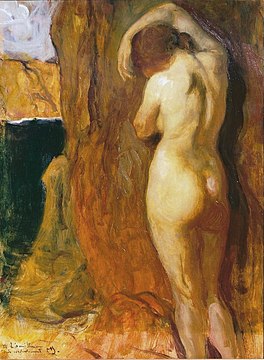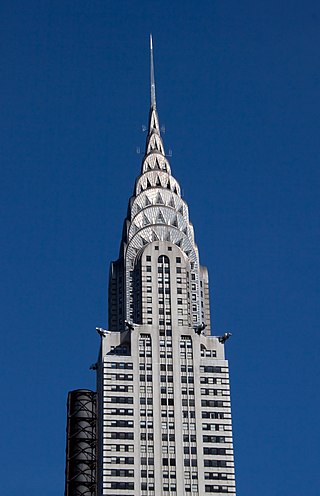
Art Deco, short for the French Arts Décoratifs, and sometimes just called Deco, is a style of visual arts, architecture, and product design, that first appeared in France in the 1910s, and flourished in the United States and Europe during the 1920s and 1930s. Through styling and design of the exterior and interior of anything from large structures to small objects, including how people look, Art Deco has influenced bridges, buildings, ships, ocean liners, trains, cars, trucks, buses, furniture, and everyday objects like radios and vacuum cleaners.

Art Nouveau is an international style of art, architecture, and applied art, especially the decorative arts. The style is known by different names in different languages: Jugendstil in German, Stile Liberty in Italian, Modernisme in Catalan, and also known as the Modern Style in English. It was popular between 1890 and 1910 during the Belle Époque period, and was a reaction against the academic art, eclecticism and historicism of 19th century architecture and decoration. It was often inspired by natural forms such as the sinuous curves of plants and flowers. Other characteristics of Art Nouveau were a sense of dynamism and movement, often given by asymmetry or whiplash lines, and the use of modern materials, particularly iron, glass, ceramics and later concrete, to create unusual forms and larger open spaces.

Alfons Maria Mucha, known internationally as Alphonse Mucha, was a Czech painter, illustrator, and graphic artist, living in Paris during the Art Nouveau period, best known for his distinctly stylized and decorative theatrical posters, particularly those of Sarah Bernhardt. He produced illustrations, advertisements, decorative panels, as well as designs, which became among the best-known images of the period.
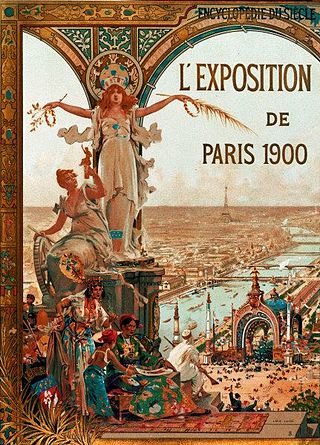
The Exposition Universelle of 1900, better known in English as the 1900 Paris Exposition, was a world's fair held in Paris, France, from 14 April to 12 November 1900, to celebrate the achievements of the past century and to accelerate development into the next. It was held at the esplanade of Les Invalides, the Champ de Mars, the Trocadéro and at the banks of the Seine between them, with an additional section in the Bois de Vincennes, and it was visited by more than 50 million people. Many international congresses and other events were held within the framework of the exposition, including the 1900 Summer Olympics.

Pierre Bonnard was a French painter, illustrator and printmaker, known especially for the stylized decorative qualities of his paintings and his bold use of color. A founding member of the Post-Impressionist group of avant-garde painters Les Nabis, his early work was strongly influenced by the work of Paul Gauguin, as well as the prints of Hokusai and other Japanese artists. Bonnard was a leading figure in the transition from Impressionism to Modernism. He painted landscapes, urban scenes, portraits and intimate domestic scenes, where the backgrounds, colors and painting style usually took precedence over the subject.

Jules Chéret was a French painter and lithographer who became a master of Belle Époque poster art. He has been called the father of the modern poster.

Eugène Samuel Grasset was a Swiss decorative artist who worked in Paris, France in a variety of creative design fields during the Belle Époque. He is considered a pioneer in Art Nouveau design.
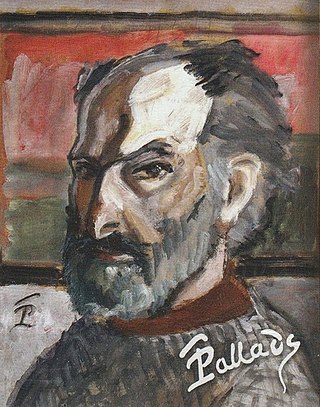
Theodor Pallady was a Romanian painter.
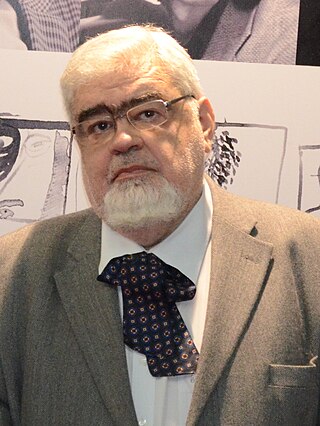
Andrei Gabriel Pleșu is a Romanian philosopher, essayist, journalist, literary and art critic. He has been intermittently involved in politics, having been appointed Minister of Culture (1989–91), Minister of Foreign Affairs (1997–99) and presidential counsellor for external affairs (2004–05).

Gabriel Badea-Päun, is a French art historian of Romanian descent.

The Liège International Exposition was a world's fair held in Liège, Belgium, from 27 April to 6 November 1905 just 8 years after a Belgian exposition held in Brussels. Intended to show Liège's industrial importance it also marked 75 years of Belgian Independence and 40 years of Leopold II's reign.
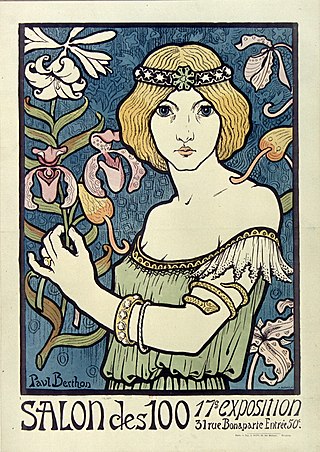
Salon des Cent was a commercial art exhibition in Paris, based at 31 Rue Bonaparte. The Salon sold color posters, prints and reproductions of artwork to the general public at reasonable prices. It was established in February 1894 by Léon Deschamps, founder of La Plume an avant garde literary and artistic magazine. It became known for its exhibitions showcasing the works of contemporary graphical artists. The salon held exhibitions until 1900. Many of the posters advertising Salon des Cent exhibitions have themselves become collectors' items.

Eugène Louis Carpezat was an acclaimed French scenographer in the Belle Époque.

Marin Haralambie Georgescu, sometimes known as Mehașgeorgescu was a Romanian Post-Impressionist painter; primarily of landscapes and buildings. Some sources give his year of birth as 1886, although this seems too early in light of his school attendance dates.
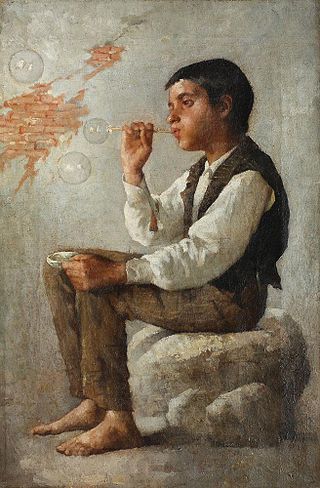
Nicolae Orval Gropeanu or, in French, Nicolas Gropeano was a Romanian painter, pastelist and illustrator; probably of Jewish ancestry. He is known primarily for genre scenes, portraits and figures. Other variations on his name as it appears in official documents include Nicolae Gropper, Naia Groper and Noah Gropper.

Art Nouveau posters and graphic arts flourished and became an important vehicle of the style, thanks to the new technologies of color lithography and color printing, which allowed the creation of and distribution of the style to a vast audience in Europe, the United States and beyond. Art was no longer confined to art galleries, but could be seen on walls and illustrated magazines.
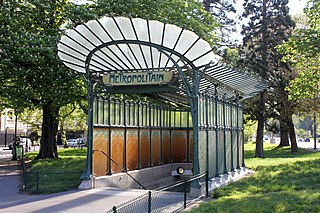
The Art Nouveau movement of architecture and design flourished in Paris from about 1895 to 1914, reaching its high point at the 1900 Paris International Exposition. with the Art Nouveau metro stations designed by Hector Guimard. It was characterized by a rejection of historicism and traditional architectural forms, and a flamboyant use of floral and vegetal designs, sinuous curving lines such as the whiplash line, and asymmetry. It was most prominent in architecture, appearing in department stores, apartment buildings, and churches; and in the decorative arts, particularly glassware, furniture, and jewelry. Besides Guimard, major artists included René Lalique in glassware, Louis Majorelle in furniture, and Alphonse Mucha in graphic arts, It spread quickly to other countries, but lost favor after 1910 and came to an end with the First World War.
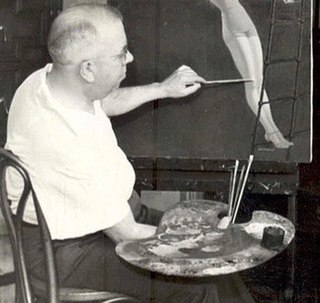
Edward Mason Eggleston was an American painter who specialized in calendar portraits of women, fashionable and fantastic. He was also a well known commercial illustrator doing work for companies such as the Fisk Tire Company, the Pennsylvania Railroad, and the Great Lakes Exposition.

Giuseppe Palanti was an Italian painter, illustrator, and urban planner, best known for his portraits, notably of Mussolini and Pius XI. He had a long collaboration with Teatro alla Scala in Milan, creating costume, set design and advertising material for multiple opera productions. He was also a major contributor towards the development of the seaside resort Milano Marittima.

Édouard Alexandre de Max was a Romanian actor who became a star in Parisian theatre. As a student at the Paris Conservatoire he won prizes for tragedy and comedy, but it was as a tragedian that he became celebrated, appearing in classic works by Shakespeare, Racine, Schiller, Victor Hugo and others, as well as new works by writers including Oscar Wilde, Victorien Sardou and Henri Bernstein. He appeared with many leading performers, including Gabrielle Réjane, but his best known and most frequent partnership was with Sarah Bernhardt.
![Mihail Simonidi; portrait by Constantin Pascali [ro] (1890) Michel Simonidy by Constantin Pascali.jpg](http://upload.wikimedia.org/wikipedia/commons/thumb/d/df/Michel_Simonidy_by_Constantin_Pascali.jpg/200px-Michel_Simonidy_by_Constantin_Pascali.jpg)


